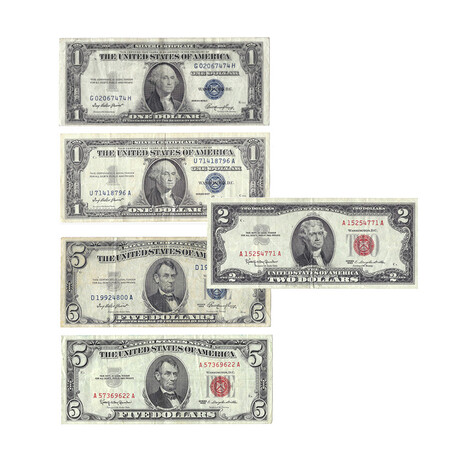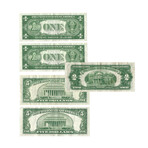Olevian Numismatic Rarities
$1 - $2 - $5 United States Currency Set of 5 // Red & Blue Seals // Lightly Circulated // 1935 to 1963 // Deluxe Collector's Pouch
Product Description
Since the introduction of federally issued paper money in 1861, several forms of U.S. currency have been produced. This 5-piece set highlights 2 key types of American paper money, dating from the post-Great Depression era to the Kennedy administration, that are highly sought after by both collectors and enthusiasts of American history alike. Each set features 3 silver certificates bearing blue treasury seals, including 1935 and 1957 series $1 notes and a 1953 $5 note, as well as 1953 or 1963 series red seal $2 and $5 legal tender notes. Each note will be housed in an archival-quality plastic sleeve and presented in a luxurious black velvet bag with certificate of authenticity.
United States Notes, also known as Legal Tender Notes, were a form of U.S. paper money issued from 1862 to 1971. Having been produced for 109 years, they were the longest running form of paper money in U.S. history. They were authorized as a form of fiat currency by the first Legal Tender Act. United States Notes acquired the name Legal Tender Notes due to the obligation that appeared on the reverse of the notes during the 1860’s, which read: “This Note is a Legal Tender for All Debts Public and Private Except Duties On Imports And Interest On The Public Debt; And Is Redeemable In Payment Of All Loans Made To The United States.”
Legal tender notes were originally placed in circulation by the U.S. Treasury to pay expenses incurred by the Union during the Civil War. During the next century, the legislation governing these notes was modified many times and numerous versions were issued by the Treasury. Prior to 1929, United States Notes were issued in a large-size format later referred to as “horse blankets.” Starting in 1929, the size of U.S. currency was reduced to its present dimensions, and the United States Notes appeared more similar to recent Federal Reserve Notes, with the distinction of having Treasury seals and serial numbers that were red instead of green. Although all United States Notes remain valid currency to this day, they are virtually non-existent in circulation and some command significant collectible premiums.
Silver certificates were a form of representative paper money issued between 1878 and 1964 in the United States. They were produced in response to silver agitation by citizens who were unhappy by the Fourth Coinage Act, which effectively placed the United States on a gold standard. The certificates were initially redeemable for their face value in silver dollar coins and later in raw silver bullion (June 24th, 1967 to June 24th, 1968). The original silver certificates from 1878 to 1923 were also printed in a large-size format. They were issued in denominations of $10 to $1,000 in 1878 and 1880, after which the $1, $2, and $5 denominations were authorized in 1886. In 1928, all U.S. banknotes, including silver certificates, were reduced in size as a cost-cutting measure to their present dimensions. Since 1968, silver certificates have been redeemable only in Federal Reserve Notes and are thus obsolete but remain legal tender at their face value and are technically an accepted form of currency.
Product Details
- Measurements
8"W x 4.25"H x 0.1"D
- OriginUnited States
— Includes Certificate Of Authenticity
— Housed In Archival Quality Acetate Protective Sleeve, Ready For Safe Storage, Display, Or Framing
Please Note: The item you receive will match the quality of the one shown, but may vary slightly due to the nature of original historical documents.
Shipping Information
-
Shipping AvailabilityUnited States
-
Shipping PolicyStandard Ground Shipping
-
Ship In3-4 weeks ⓘ
-
Return PolicyFinal sale, not eligible for return or cancellation































































